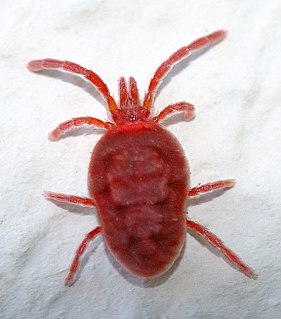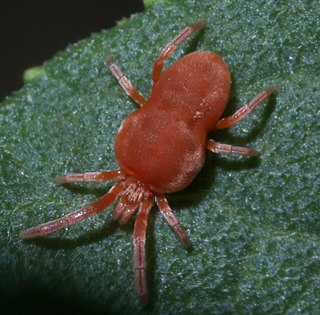
Mites are small arachnids. Mites span two large orders of arachnids, the Acariformes and the Parasitiformes, which were historically grouped together in the subclass Acari, but genetic analysis does not show clear evidence of a close relationship.

The Acariformes, also known as the Actinotrichida, are the most diverse of the two superorders of mites. Over 32,000 described species are found in 351 families, with an estimated total of 440,000 to 929,000 species, including undescribed species.

Raoiella indica, commonly known as the red palm mite, is a species of mite belonging to the family Tenuipalpidae. A pest of several species of palm in the Middle East and South East Asia, it is now becoming established throughout the Caribbean. The invasion of this species is the biggest mite explosion ever observed in the Americas.
Charletonia cuglierensis is a species of mite belonging to the family Erythraeidae, so named after its type locality. C. cuglierensis belongs to the group of species which possess two setae between coxae II and III. It differs from its cogenerate species by length measurements. It was first found in Sardinia, 6 kilometres (3.7 mi) south of Cuglieri.
Leptus pozzoicus is a species of mite. It is named after Porto Pozzo, near Santa Teresa Gallura, the place where the species was first collected. L. pozzoicus belongs to the group of species with two palpgenualae, and that have over four setae between coxalae II and III. It differs from its cogenerate species by various length measurements.
Charletonia austisensis is a species of mite belonging to the family Erythraeidae. C. austisensis belongs to the species group with two setae between coxae II and III. It differs from its cogenerate species by various length measurements. The species was first found in Austis, Sardinia, after which it is named.
Abrolophus mirabelae is a species of mite belonging to the family Erythraeidae. It belongs to the group of species that have comb-like setae.
Erythraeus moeritzensis is a species of mite belonging to the family Erythraeidae. It belongs to the group of species that has a basifemoral, setal formula 3-3-3.
Erythraeus berninensis is a species of mite belonging to the family Erythraeidae. It belongs to the group of species that has a basifemoral, setal formula 3-3-3.
Allothrombium polikarpi is a species of mite belonging to the family Trombidiidae, first described from Greece.
Podothrombium manolatesicus is a species of mite belonging to the Trombidiidae family, first derived from Greece.
Erythraeus (Zaracarus) passidonicus is a species of mite belonging to the family Erythraeidae, first described from Greece.
Erythraeus kastaniensis is a species of mite belonging to the family Erythraeidae, first described from Greece.
Charletonia samosensis is a species of mite belonging to the family Erythraeidae, first described from Greece.
Neophyllobius is a genus of mites.

Abrolophus is a genus of mites in the family Erythraeidae, first described in 1891 by Antonio Berlese.
Magdalena Kathrina Petronella Smith Meyer was a South African acarologist who was regarded as a world authority on plant-feeding mites of agricultural importance and was known as the "mother of red-spider mites of the world". She described more than 700 new species and 25 new genera, mostly of mites of agricultural importance. Meyer was involved in the promotion of biological control of mites using predatory mites, spiders and insects.

Allothrombium is a genus of mites belonging to the family Trombidiidae.
Charletonia is a genus of mites belonging to the family Erythraeidae.



